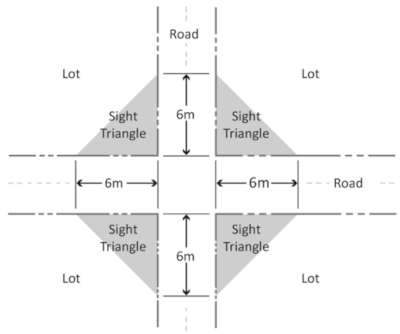 Question: We have too many blind corners in our communities says a correspondent. They have seen many near misses because of fences, trees and hedges blocking the view of drivers who are attempting to turn onto a street.
Question: We have too many blind corners in our communities says a correspondent. They have seen many near misses because of fences, trees and hedges blocking the view of drivers who are attempting to turn onto a street.
It is often impossible to see cross traffic where the growth of grass and weeds force drivers to pull out too far in order to see oncoming traffic.
Many 4-way stops have hedges and trees growing that sometimes block the view of stop signs entirely.
Property owners should be told when their bushes and trees pose a hazard to visibility and perhaps be asked to trim them, or have the city do it.
Municipal Bylaws
The City of Port Alberni's zoning bylaw is one example of how sight triangles at intersections in the city must be created and maintained.
Notwithstanding any other section of this Bylaw, on a corner lot at any street or lane intersection, except for a permitted principal building, there shall be no obstruction of the line of vision above a height of 1.25 m (4.1 ft) and below a height of 3.0 m (9.8 ft) in the triangular area contained by lines extending to points 6 m along each lot line from the corner of the lot and a diagonal line connecting those points.
Bylaw Enforcement
If the obstruction is from someone's property, the bylaw can be used as a remedy to improve the view.
When the view obstruction is growing from or situated on the boulevard, then it is the municipality's responsibility.
Contact the municipality responsible and explain the difficulty. Bylaw enforcement will deal with the property owners and public works will do the maintenance for public property. Be persistent if no action is taken. The most effective method is likely sending a written notice to city council.
Provincial Highways
The same process works with provincial highways. The British Columbia Active Transportation Design Guide explains how sight lines are decided starting on page G10.
In that case though, the agency to advise is the road maintenance contractor with a copy to the district office of the Ministry of Transportation and Infrastructure. They have the authority to take action under the Transportation Act.
Coping with a Bad View
Drivers who are faced with poor view of cross traffic at an intersection must stop as required. Having done that, creep forward to a point where you can see without interfering with cross traffic and make a second stop if necessary. Proceed when it is safe to do so.
Share This Article
Part 3 of the little known Provincial Public Undertakings Regulation outlines the sight lines and triangles to be considered on provincial roadways. There's some other interesting tidbits in this regulation too (for example, it's it's illegal to repair a flat on several of the Fraser River bridges). The Active Transportation Design Guide is good, but in the intro it makes it clear that it is less for highways and more for cities (except part F).
- Log in to post comments
This used to be part of the now repealed Highway Act. I went searching this morning and did not find it so thanks very much for sharing!
- Log in to post comments
No Problem!
I am not sure why this secondary hidden regulation exists as it does. It seems many don't know about it, and for that reason it doesn't get updated. For example, Section 3 of the regulation makes it illegal to walk or cycle on "any part" of the Port Mann Bridge which was obviously written for the old structure. The new structure has big wide multi-use paths but at least according to this regulation everyone using them is a law breaker.
- Log in to post comments
In North Vancouver, the biggest culprit appears to be the city/district. All too often, street-scaping is what obstructs the view. Add in electrical kiosks, benches, signs and construction hoarding it can be very difficult to see if there is side traffic.
- Log in to post comments
Agreed that some intersections (such as Keith at Lonsdale) are challenging, but it's my opinion that the conversion where possible to traffic circles instead of 2-way or 4-way stops in the City has been great.
The District has a tendency only to respond to calls from homeowners, such as when the sidewalks become almost impassable due to growth. But they're equally slow to cut down branches that are blocking signs. Reactive rather than proactive.
Mostly, this stuff comes down to bylaws. And those guys and gals are much happier when they can ticket unoccupied parked cars exceeding hourly limits, rather than cars parked too close to alleyways and intersections, large vehicles blocking road signs, etc.
- Log in to post comments
Can you expand on these regulations, ie; is it true that all road construction must meet a provincial standard minimum? I ask this for the reason regarding bylaws. Smaller towns, villages, and municipalities may not have specific bylaws to address this issue, which would mean that provincial standards may be the regulations counsels, district, or area directors would have to meet on behalf or their community.
I had an incident in Victoria years back where a road sign was mounted too close to the curb. This resulted in the sign damaging my rear corner clearance light. I was successful in getting the light replaced, furthermore (whether they followed through I never checked) I addressed the harsh camber at curbside in the road demonstrating how it exacerbated the issue and contributed to the position the sign was placed.
Regarding your story's issue. Why can't the people we pay to look after these problems be proactive about them? Do we need a provincial traffic sheriff to police these issues with the authority to write hefty fines to local governments for failing to keep the roads up to minimum standards? I bet if the fines came out of the sitting politicians pay, our roads would be properly maintained.
- Log in to post comments
As far as I am aware, both the MOTI and the municipalities follow the Transportation Association of Canada's Geometric Design Guidelines. They are not available on line and are significantly expensive to buy.
The Province of BC has their own supplement to this guide and it is available on line.
In general, it is followed as closely as possible because failing to do so could lead to legal liability in the event of a problem.
In my experience, bylaw enforcement for things like this is often done only in response to complaint. If you see something that needs to be corrected, wondering why it hasn't been done and carrying on with your day is not the best choice.
- Log in to post comments
Big 4x4 pickup trucks and SUV's parked almost to the corner make my street particularly difficult to cross. Furthermore the street I am trying to cross is slightly elevated and at the stop sign you are lower still.
I asked the municipality to extend the yellow curbs twice and after about 8 months they did it. Still a very difficult place to cross.
- Log in to post comments
I was on city council in City of Trail and we had sightline problems in our city and outside our adjoint jurisdictions in the Regional District especially in winter when heavy snow and highways as well as city plows would plow snow in high piles on all sides of intersections. Many serious accidents occurred at main highway and side road intersections due to no sight of traffic under these conditions.
- Log in to post comments
- Log in to post comments


Regulations